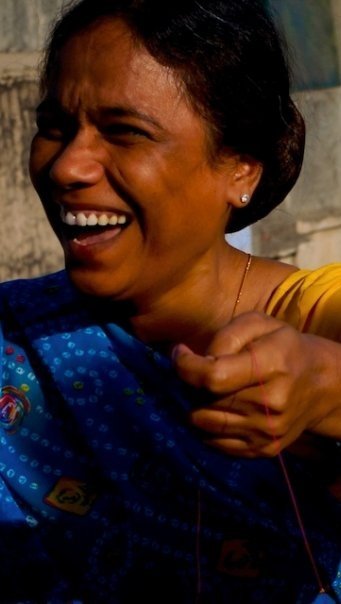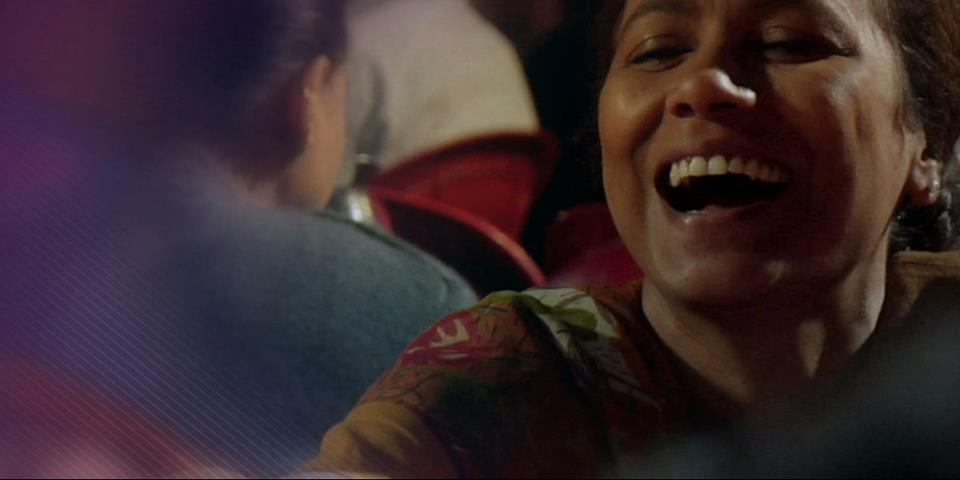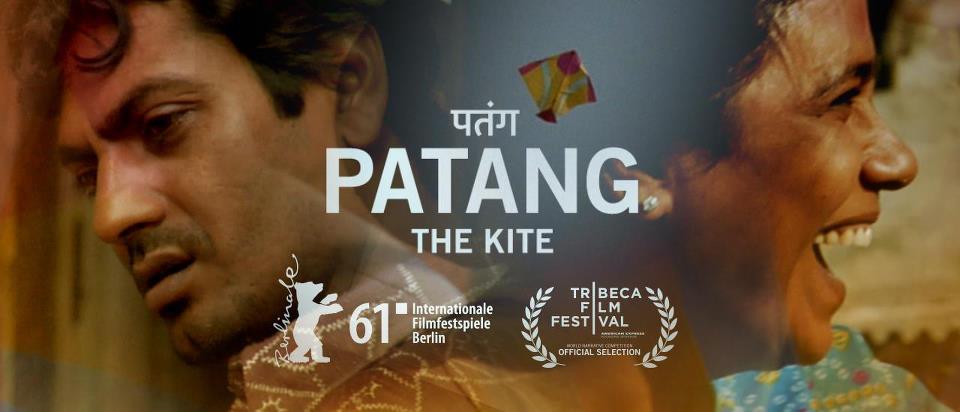 One of the highlights of Patang is most definitely Seema Biswas’ (Bandit Queen, Water) understated but powerful performance. Director Prashant Bhargava said about his lead actress, “Seema is an amazing actor. She really brings this additional level of absorbing the character completely within and the way she physicalizes behavior sometimes is absolutely amazing.” I certainly agree and in fact, one of her scenes in the film literally made me gasp and she did not even say a word. It was a small moment but in that one action she showed a world full of pain and frustration. One of the challenges to playing Sudha, according to Ms. Biswas, was that only very rarely do you see to the pain inside, because most of the time Sudha shows in her smile and her caring that life is beautiful. Her power is that she ‘holds on to her happiness. Her little, little happiness’. Read on to see what else the actress told us about her role, working with non-actors, and what she thought about her work in Patang.
One of the highlights of Patang is most definitely Seema Biswas’ (Bandit Queen, Water) understated but powerful performance. Director Prashant Bhargava said about his lead actress, “Seema is an amazing actor. She really brings this additional level of absorbing the character completely within and the way she physicalizes behavior sometimes is absolutely amazing.” I certainly agree and in fact, one of her scenes in the film literally made me gasp and she did not even say a word. It was a small moment but in that one action she showed a world full of pain and frustration. One of the challenges to playing Sudha, according to Ms. Biswas, was that only very rarely do you see to the pain inside, because most of the time Sudha shows in her smile and her caring that life is beautiful. Her power is that she ‘holds on to her happiness. Her little, little happiness’. Read on to see what else the actress told us about her role, working with non-actors, and what she thought about her work in Patang.
Tell us about your role in the film.
I am one of the major characters named Sudha who is the sister-in-law of the main character. She’s like a typical Indian housewife who is really balancing the tension and crisis just to cope with the situation. She’s a very down-to-earth typical mother. She was a very common and real type of character.
What made you want to play her?
When portraying these kinds of characters you need not perform. It’s a very smooth and one level kind of character where there is no drama, there is no climax. It’s just easy going. The character has a lot of emotion going on inside her, but she cannot show it on her face. You can’t show any pain, any anger. On her face there is nothing, sometimes you can see that there is some conflict inside, but very rarely. That was a challenge to play. It was interesting to me because throughout the film I had to perform as if there was no problem: life is smooth – life is beautiful.
 There was one scene that just struck me, the one where you tear the pink napkin.
There was one scene that just struck me, the one where you tear the pink napkin.
For the most part Sudha is happy that her brother-in-law has come visit her in Delhi to celebrate the kite festival. We all are very happy because he has come after many years. My brother-in-law is highly ambitious, highly a city-go kind of person who wants to settle in town with comfort, facilities and luxuries. He doesn’t ever think of or care for his elder brother’s family and his mother. So I was the person who was looking after my mother-in-law, looking after the old house. It was a big responsibility for me to look after the family being a typical housewife but I somehow managed to earn a little money giving tuitions to little children. Later on I came to know that my brother-in-law had come with a motive to sell the old house and take his share. He was going to shift the people who have lived here and created a lot of memories in this house to a simple little apartment. For me I had this imagination I had made about my brother-in-law that he is sensitive, human and who is concerned for everybody. When this family came to see me to ask my hand in marriage I was highly impressed by this man who seemed very human at the time. I thought this family is very nice, well cultured and sensitive and human. So his gesture to sell the house left me a little bit shattered. But being the kind of person I am, I try to balance it and say okay, it’s human nature everyone cannot be the same. It doesn’t mean that he’s the enemy. On the inside I am shocked and shattered, but on the outside it does not show on my face. And though it was not in the scene, maybe one night I could not sleep and I was weeping all night, but morning comes and I began the day like any other day like a typical mother – cooking, preparing breakfast and lunch because they are leaving and I wanted to give them a happy ending. Come again, have fun again. Try and show them to always think about happiness, don’t think about the past that is sad. Just don’t keep holding those bad memories in life. Move ahead with happiness because that is what life is all about. Life is beautiful. So over and over in my mind it is something else, but on my face I am not showing it at all. That is the character and that was interesting for me.
As an actor you get tempted to show lots of layers and show through your performance the caliber of your talent and show lots of emotions. But this did not allow it because keeping the character in mind you don’t show emotions.

Patang was shot very differently and many times with very long takes. Was it a difficult film to make?
Yeah. That was very challenging for me as an actor. At the same time because basically I am a theater person/actor, I took this task very positively and enjoyed it as if it was for a play and the hours and hours of rehearsal, that kind of thing. Camera is on and for six-seven hours, I am this character, living with the other characters for a long time. Then you have the non-actors who would break the frame of the scenes and be spontaneous; maybe the scene required something different or had a different message. I had the responsibility of getting them back into the scene and give them a hint you are not doing this scene properly. Handling non-actors during the scene on camera for six-seven hours, living with this character and balancing it all both as the character Sudha and also the actor Seema Biswas… that was a challenge, but at the same time I enjoyed it. It was interesting and a new kind of experience.
What did you think when you saw the final product out of all the hours you all shot?
Honestly speaking, the first time I see a film, I have this habit of always criticizing myself, looking at my performance, where am I going and what am I doing, cursing myself why did I do this, I could have done that this way or that way. That is always what my initial reaction is and it disturbs me. Later on as I recollect the whole process I think of the amazing visuals, the landscape, the colors. I see the small nuisances of a scene whether it’s a silent scene or with kids or at a market place with characters that are non-actors but are real, with shots being done with a hidden camera. So those are very interesting elements.
 The film is about the kite festival. Kites for me represent hope and positivity. Hope is positive. For me, the message is there is always hope, life is beautiful, life is colorful. Some kites fall and break. Somebody snatches it, somebody wanted it. It is kind of like dreams. You know you are running after dreams. You catch it and the dream becomes reality. Whatever dream you see should be fulfilled. So my character mends that broken kite and gives it to her brother-in-law as if saying that nothing has broken. You said something, you wanted to sell the house, and you hurt some people in my family but never mind. Everything will be fine. There is hope.
The film is about the kite festival. Kites for me represent hope and positivity. Hope is positive. For me, the message is there is always hope, life is beautiful, life is colorful. Some kites fall and break. Somebody snatches it, somebody wanted it. It is kind of like dreams. You know you are running after dreams. You catch it and the dream becomes reality. Whatever dream you see should be fulfilled. So my character mends that broken kite and gives it to her brother-in-law as if saying that nothing has broken. You said something, you wanted to sell the house, and you hurt some people in my family but never mind. Everything will be fine. There is hope.
The film has been tremendously accepted and applauded at many film festivals all over the world. What does that mean to you?
It feels really good. I did not expect it. No matter if it is anybody’s film but when I am in that film I always underestimate it – always. (Laughs) This was a very pleasant surprise. I was there at the LA Indian festival and the Ebert Festival and there was so much positive response. It was hugely appreciated and it had such a warm welcome and was accepted by them. It was a wonderful experience. The audience was so sensitive and highly brilliant. I am so happy that the Patang film has gotten the appreciation.
You can Seema’s quietly powerful performance in Patang when in opens in theaters in the US and Canada on June 15th.










